This website is supported by its readers. If you click one of my links I may earn a commission. I am also a participant in the Amazon affiliates program and I will also earn a commission from qualified purchases.
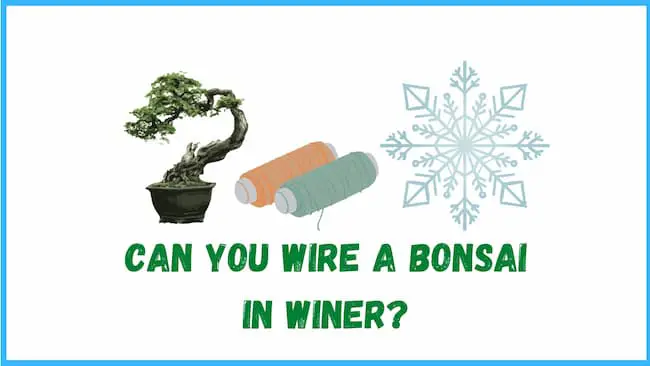
With winter fast approaching ( for those living in the northern hemisphere at least), many of us are starting to prepare our bonsai trees for fall and winter. While I wire my bonsai trees during the spring, having moved house this year meant I had to delay this process. So can you wire a bonsai tree in winter?
Bonsai trees can be wired during the winter. For best results, wire bonsai trees in the last few weeks of winter just before spring. This will allow your bonsai to recover from any damage caused by the wire during the spring and summer growing seasons.
Bonsai trees can be wired at any time of year.
Deciduous bonsai, in particular, are easier to wire during the winter due to their leaves falling off in the fall. This can make it easier to get into all the hard-to-reach areas of the tree.
So what are the advantages and disadvantages of wiring a bonsai tree during the winter? And how exactly do you wire a bonsai tree during the winter? Keep reading to find out more!
Just a quick heads up, over the past three years of running Plantpaladin, hundreds of people have asked for product recommendations. As such, You can find my favorite indoor bonsai tree here (link takes you to Bonsaiboy), my favorite outdoor bonsai tree (link takes you to Bonsaiboy), or have a look at all the products I recommend here.
Can you wire bonsai in winter?
Winter can often be tricky for those of us with bonsai trees, especially those living in milder climates.
The general advice around training bonsai is to avoid it until the early spring.
This advice isn’t realistic for many of us who live busy lives and keep bonsai trees as a hobby.
Finding myself in this situation, I got in touch with a few bonsai experts, visited my local botanical gardens, and even surveyed 20 plant paladin readers, asking them the question – Can you wire bonsai in winter?
To summarize:
- You can train bonsai trees with wire in winter.
- Wiring works particularly well for deciduous bonsai tree species such as Oak or Acer trees whose leaves fall off during the fall.
- With no leaves, training and placing the wire and moving branches into position is a lot easier than it would be if the tree was fully leaved or had a dense canopy.
- Conifer and evergreen trees such as Juniper bonsai can also be wired during the winter, although it will be slightly more complicated.
- For best results when wiring bonsai in winter, aim to do so just before the spring – at the end of February.
- However, the wiring you should undertake on your bonsai during winter will vary from species to species, with some having more challenging, intricate branches to move and manipulate with wire during winter.
Which bonsai species can be wired in winter
Chinese Elm, Oak, Ficus, Maple, and Pine species can all be wired during the winter. Juniper and evergreen bonsai can be wired, although the needle-like leaves may make this more challenging. Tropical bonsai tree species such as Olive or Jade may be less susceptible to wiring in winter.
So now we know that most bonsai trees can be wired in winter; what are the differences between species?
After all, evergreens are typically a little harder to wire when compared to deciduous and semi-deciduous species such as Chinese Elms.
The good news, however, is that regardless of the species, if you take care with wiring your bonsai tree and not pressing the wire too close against the tree branches, then most species can be wired effectively.
Some general rules of thumb I follow are
Broadleaf bonsai species
Such as Cherry, Willows, and Crabapple; while all can be wired in winter, I would try to leave until the spring/summer.
The leaves will harden up, making it easier to place the wire between branches. Wiring broadleaf species in winter may prove difficult, with the branches hardening up.
Semi-Decdouse and deciduous bonsai
So common bonsai tree species such as Chinese Elm, Ficus, and Fukien Tea can all easily be wired in the winter.
This is because their leaves will fall during winter, making maneuvering the wire between branches easier.
These tree branches also do not become excessively hard and brittle during winter making it easy not to damage the tree.
Tropical bonsai
These tree species are used in warmer climates, such as Olive or Jade bonsai, and can also be wired in winter; however, they prefer to be kept outdoorsy in warmer conditions.
As such, I would opt for wiring these trees during the early spring when temperatures pick up slightly.
Evergreen tree
Evergreen trees such as cedars, pines, and Junipers can prove tricky to wire at the best of times due to their tip-like leaves.
During the spring and summer growing seasons, the cambium of these trees separates quickly, making wiring tricky to undertake.
Wiring in the fall or winter is ideal for these trees.
Now the exact differences between species vary greatly, so to help, I’ve created a table below with some of the most common species of bonsai and if they are susceptible to wiring in winter:
Species | Can you wire in winter |
Chinese Elm | Yes |
Ficus | Yes |
Juniper | Yes |
Scots Pine | Yes |
Oak | Yes, although early spring works better |
Maple | Yes, although early spring works better |
Jade | Yes, although spring and summer work better |
Olive | Yes, although spring and summer work better |
Cherry | Yes, although spring and summer work better |
Crabapple | Yes, although spring and summer work better |
Temperature and wiring bonsai in winter
So one aspect that we have not touched upon is how temperature impacts your ability to wire bonsai tree.
While bonsai species from warmer climates, such as Olive or Jade trees, prefer warmer climates. Wiring bonsai trees in too cool a temperature can also be dangerous – regardless of how well adapted a bonsai tree is to winter.
For example, Juniper bonsai trees are super hardy and love being kept outdoors during cold winters.
If the temperature range outdoors drops too low, even for these hardy trees – below 10F ( -12C), these trees will suffer.
As such, before wiring in winter, consider the average winter temperature for the area where you live, during the winter, and the best temperature range to keep your bonsai tree at before deciding to wire in winter.
To help do this, I would check out the USDA plant hardiness Zones guide:
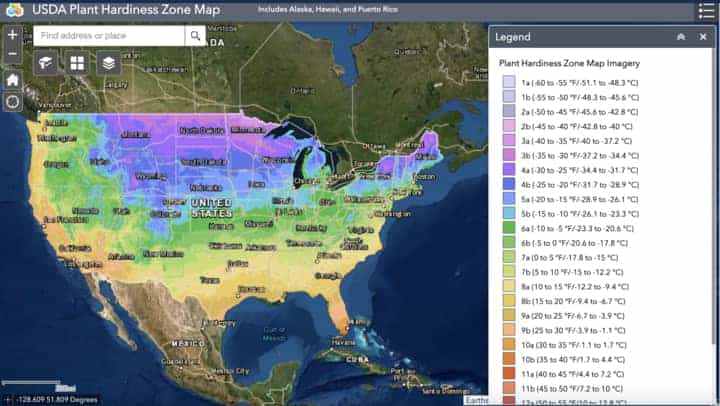
Advantages of wiring bonsai in winter
The significant advantages of wiring bonsai in winter include the following:
Time-saving
One of the biggest reasons people opt for wiring bonsai in winter is the amount of time it saves.
For many of us, bonsai is a hobby, and taking the hours needed to wire a bonsai tree during the growing season can be challenging.
Wiring a bonsai over the winter can prove to be a fast practice.
More accessible to wire deciduous trees
Deciduous bonsai trees, that is, bonsai trees that drop their leaves in the fall and winter, can be challenging to the wire during the spring and summer when they have thick, dense canopies.
A significant advantage then of wiring these types of trees during the winter is that getting to the branches and twigs is much easier than it would be if you were trying to maneuver the wire around the thick canopy of leaves.
Branches are easier to move
Some (but not all) bonsai tree species, such as Juniper, have thick branches filled with sap that can be difficult to work with during the spring and summer.
In winter, the sap levels tend to decrease, meaning that moving these heavier branches becomes easier.
On top of this, juniper species tend to have sensitive cambium during the spring and summer, so wiring in the winter works best.
Disadvantages of wiring in winter
Now, there are a few disadvantages to wiring bonsai in winter, which include the following:
Easier for damage to occur
If the wire you have used on your bonsai tree is too tightly wrapped around your tree, this can cause minor cuts on the branches of your bonsai.
This will mean that water in cold temperatures will freeze in these minor cuts and potentially cause small cracks and gouges in your tree.
Wiring can also lead to excessive pruning on the tree, causing further damage.
Higher chance of drying out your tree
With the dry arid air of winter, it is common for many bonsai trees to dry out and dehydrate in winter.
It’s one of the reasons why mulching and mosses are used to add this moisture during the cold months.
Winter then adds a lot of stress and pressure to the tree, so by wiring your bonsai, you will be adding a lot of extra stress on top of the stresses it is going through already.
You likely need to move the tree indoors
If you are wiring a more tropical tree, you will need to move these trees indoors in warmer conditions.
As such, these temperature changes can cause additional stress in your bonsai tree, mainly if being kept outdoors for most of the year.
When winter is good to wire your bonsai,
Late winter, a week or two before spring starts, is the best time to wire a bonsai tree for most species. This will ensure that by the spring, you can remove the wire, and the bonsai can recover from the growing season.
When to avoid wiring your bonsai in winter
Sometimes, you should avoid wiring your bonsai tree in winter.
These include:
- If severe wiring has just taken place a few weeks before
- If your bonsai has recently had an insect infestation.
- Bacterial or mold infections have occurred on your tree.
- If the wiring is causing too much excessive damage to your tree’s bark.
- The bonsai species you are growing is tropical or used to dry, hot conditions year-round.
Should you remove wire in winter
You should remove wire on bonsai trees in the spring. About 4 to 6 weeks after it has been placed on your bonsai. If wiring occurs in late winter, then remove the wire at the end of March or the beginning of April.
What is the best wire to use on a bonsai in winter?
Copper and Aluminum wire are the best types of wire to use on your bonsai tree, both in winter and any other part of the year. You can use alternatives such as yarn and Jute rope to use as organic wiring materials.
To read up more on wiring alternatives, check out my post here.
How to wire a bonsai tree in winter
Wiring a bonsai in winter is generally no different than wiring a bonsai at any other time of the year.
I strongly suggest looking at my post on wiring bonsai here.
That being said to summarise:
Clean up any excess foliage
This will make it easier to get to the branches of your tree.

Select the right wiring
You want to aim for the wire you use to be about 1/3rd the size of your branch.
Before selecting the required wire size, get an idea of the branches you will need to wire.

Wrap your wire around the trunk of the tree
Cut your wire to size so that it is long enough to go around the trunk of your tree and branches,
Ensure it has a little extra wire in case mistakes are made.
As such, I suggest a 30% on top of the size of the branch.
Then wrap the wire around the tree’s trunk to create an anchor point.

Wrap the branches
Next up, wrap the wire at a 45-degree around the branch you want to move.
Then using your index finger and thumb, move this wire into position.

Repeat this process across the other branches
Repeat this process using single or double wiring across the other branches.
Use smaller, thinner wire for smaller tertiary branches and twigs.
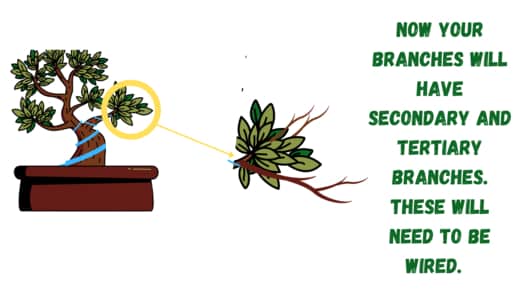
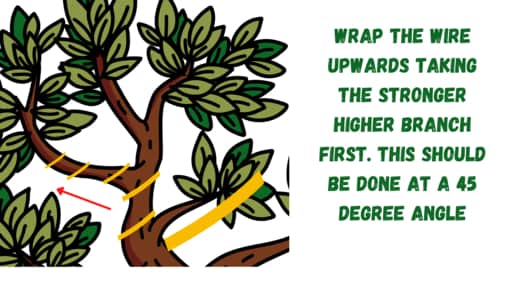
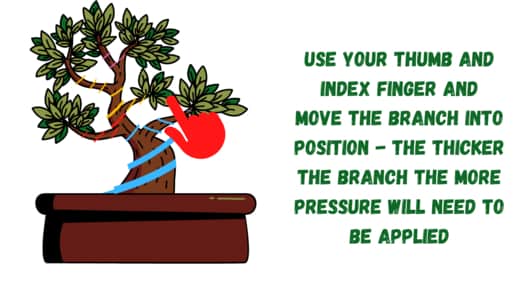
How to wire a bonsai tree season by season
So now we know how to wire a bonsai tree in the winter. What about the other seasons?
Most experts agree that late winter or early spring is the best time to wire most bonsai trees.
Trees will generally be easier to access due to the lack of leaves, and the branches may have hardened, making them ideal for moving.
During spring and summer, you can still undertake wiring; however, bonsai trees’ overgrowing during this period can be easy to snap or break branches and twigs by mistake.
Fall can be difficult due to new buds forming.
Wiring can impact the growth of the new buds, which will be essential for the continued growth of your bonsai tree.
Season | Should you wire |
Winter | Yes - late winter works the best |
Spring | Yes, Early spring works the best |
Summer | Yes, although be careful of breaking branches and twigs which may be more delicate |
Fall | Avoid due to new growth in deciduous trees. |
Survey results – can you wire a bonsai in winter?
Finally, I wanted to finish off by asking ten plant paladin readers if they wire their bonsai trees in winter.
Here are the results:
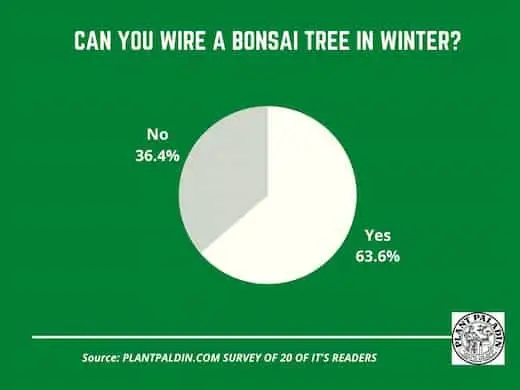
My top picks for the gear you will need!
So like I mentioned earlier, over the past three years of running PlantPaladin, hundreds of people have asked me for my recommendations on the best bonsai gear on the market.
Having spent thousands of dollars on bonsai items these past few years and tested at least 100 bonsai-specific products, I’ve listed my favorite products below – All of which I highly recommend and think you can get great value.
They can purchase directly by clicking the link to take them to Amazon.
Bonsai Tool Set: One of the significant challenges I’ve had is finding a toolset that was not only durable but didn’t break the bank. SOLIGT has recently developed a fantastic bonsai tool set that covers all the tools you need to trim, prune, and repot your trees. – You can grab it here.
Complete Bonsai Set: Many of you will want to grow your bonsai trees entirely from scratch, but finding the varicose seeds, pots, and other items in one place can be challenging. Leaves and Sole then have created a complete bonsai set that I’ve personally used that ticks all the boxes. You can grab it here.
Bonsai wire: The number of times I’ve run out of wire for my bonsai or purchased cheap bonsai wire that doesn’t do the job is embarrassing for me to admit. After a lot of trial and error, I found that using Hotop’s aluminum bonsai wire is one of the best options on the market. This can easily be used for both indoor and outdoor bonsai. You can grab it here.
This post was written by Fehed Nicass who has been passionate about bonsai for over 3 years. He currently resides in the UK and works in sales.

